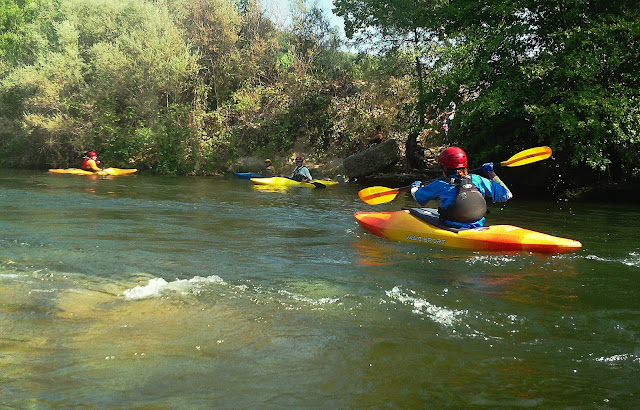 |
| On a rainy spring day on Beers Lake in Minnesota's Maplewood State Park |
Wading in just a few feet into the water, even with neoprene boots, gave me a quick reminder it was April and not July. The water was still dangerously cold.
“Many newer paddlers don’t realize that even though the air temperature is warm, the water can still be ice cold,” said Todd Robertson, certified paddling instructor at the Iowa Department of Natural Resources told the Des Moines Register.
“As spring arrives, it takes a while for that water to warm up, making it necessary to have a wet or dry suit on and a change of dry clothes in a dry bag in case you dump your boat,” Robertson said. “Remember, wet clothing and cold water make for hypothermic conditions.”
Outlining this safety factor, Austin Kayak www.ack.com/blog has put together five points for anyone looking to get a jump start on their paddling season this spring.
1. Start With The the Basics
Keeping warm on the water as temperatures start to drop isn’t as hard as you think. Make sure you have all the basics like your PFD, spray skirt (for sit insides), bilge pump (also for sit insides), whistle, paddle leash and first aid kit. Add to this list a complete change of clothes in a dry bag just in case you fall in the water and want to change later. It may go without saying, but be sure that none of the clothes you wear or pack are cotton. Cotton dries slow, meaning you’re going to be cold if there’s even a slight breeze out, plus it weighs you down. Just don’t do it. What should you wear? Well, I was getting to that…2. Layering Is A Paddlers Best Friend Against the Cold
You’ll want to take on the cold with the appropriate paddling apparel, and that means layering with synthetic materials proven to keep you both warm and dry. I’d recommend starting with a good base layer in early fall and then adding piece by piece as the weather gets colder. Refer to our Cold Weather Paddling Apparel Layering Guide to see how you can best do this.Keep in mind that when it gets colder it will be more important to keep as much covered as you can and this means investing in things like neoprene socks, paddling gloves (or pogies) and headwear. One really great headwear option that’s just arrived at ACK is the Buff Thermal Pro, which uses a Polartec fabric to cover your neck and head as well as merino wool for your chin and mouth.
3. Don’t Paddle On An Empty Stomach
It’s important that you hydrate whenever you’re paddling but it’s easy to forget when the sun isn’t beating down on you. In fact, keeping well fed and hydrated will help minimize the risk of hypothermia if you happen to fall in the water. Carbohydrates and foods high in fat will give you both energy and warmth. On especially cold nights, I recommend bringing along a vacuum sealed flask of your favorite warm beverage (non-alcoholic) like hot chocolate or cider.4. Familiarize Yourself With Rescue Techniques
Even for a paddler who is dressed for cold water immersion, a swim can still bring on hypothermia if you aren’t prepared. Knowledge of rescue techniques and regular practice with your paddling companions (and cold water paddlers SHOULD have partners) are essential. Rolling is particularly important to know for sea kayakers or anyone else in a sit-inside because the inability to perform this will mean an extended exposure to cold water. All paddlers should also be able to re-enter their kayak should an accidental capsize occur. If you aren’t comfortable with these skills, make sure someone in your group knows this and is prepared to help.5. Wear Your PFD!
At risk of sounding like a broken record, my last tip is a reminder to wear your PFD. Not only is it an added layer of insulation but they will keep your head above water, increasing your ability to fight against hypothermia dramatically. Just take a 10-minute lesson from the Cold Water Boot Camp if you don’t believe me.Also remember, cold water is not the only danger this time of year. Springtime floods are common in many rivers. At flood, stage rivers can be deadly and filled with hazards. Trees branches and other debris have been trapped in the ice and when the river thaws, it moves downstream and is deposited at the base of bridge pilings and the outside of tight bends in the river. Good knowledge of the river is vital when paddling in high water, along with good boat control skills and understanding how to navigate around these hazards is crucial to remaining safe while on the river.
Canoes, kayaks, and stand-up paddleboards were involved in 20% of all boating casualties in 2013 according to the U.S. Coast Guard 2013 Recreational Boating Statistics. That year 109 people died as a result of kayak or canoe mishap. Sobering statics on how safety practices should always be exercised no matter what the season.
This article was originally published in Outside Adventure to the Max on March 27, 2015.














































